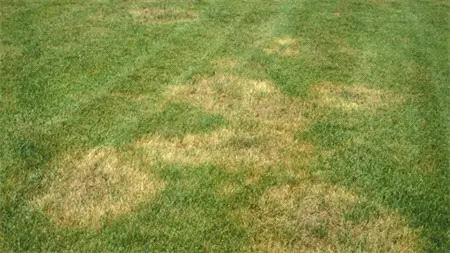
Brown Patch is a leaf disease that can appear on your lawn during periods of hot and humid weather. It will often appear first as rough, circular patches varying in size, from a few inches to several feet across. In the early morning dew, you may notice something that looks like purple or grayish-brown cobwebs; this is actually fungal growth. Brown patch is caused by the Rhizoctonia fungi, which infects the grass foliage and crowns. This fungus colonizes the organic matter in the thatch layer, and, during times of stressful conditions, can cause disease in the grass plant. Brown patch is likely to develop in cool season grasses when temperatures are above 29°C with high relative humidity. While the disease rarely causes damage to Kentucky Bluegrass, it can cause significant damage to Tall Fescue, Perennial Ryegrass, and Creeping Bentgrass.
Brown Patch is very difficult to control, as it thrives in hot and humid weather conditions. In most cases, the spread of the disease will be reduced by changes in temperature and weather, but you can also adjust some cultural practices to improve the health of the lawn and limit the spread. However, depending on the size of the infestation and the scope of the damage, other forms of control may be necessary and you may need to repair heavily damaged areas with sod or the appropriate grass seed.
A thick, healthy, well-maintained lawn is the best line of defense. Here’s how you can adjust your beneficial cultural practices to reduce the spread of Brown Patch:
Your local Weed Man professional may be able to offer other solutions and recommend the best form of treatment that is available to improve the conditions of your lawn.


The adult mole is a small, burrowing mammal, commonly found in lawns and gardens. It has dark gray or brown velvety fur and a cylindrical body that is 5 to 8 inches long. It has small eyes and broad f...

Annual Bluegrass, or Poa Annua, is one of the most common varieties of undesirable weed grass that homeowners encounter on their lawns. In fact, almost every lawn will have some Annual Bluegrass. It c...

Nutsedge is a type of weed that grows in warm and humid climates. It is often referred to as "nutgrass" because of its nut-like tubers, but it is a true sedge and not a grass plant. Sedges are difficu...